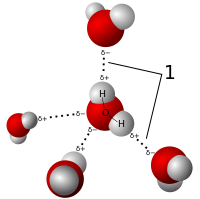
Photo from wikipedia
Formic acid (HCOOH) can be catalytically decomposed into H2 and CO2 and is a promising hydrogen storage material. As H2 production catalysts, Cu surfaces allow selective HCOOH decarboxylation; however, the… Click to show full abstract
Formic acid (HCOOH) can be catalytically decomposed into H2 and CO2 and is a promising hydrogen storage material. As H2 production catalysts, Cu surfaces allow selective HCOOH decarboxylation; however, the on-surface HCOOH decomposition reaction pathway remains controversial. In this study, the temperature dependence of the HCOOH/Cu(111) adsorption structures is elucidated by scanning tunneling microscopy and non-contact atomic force microscopy, establishing the adsorbate chemical species using density functional theory. 2D HCOOH islands at 80 K, linear chains of HCOOH and monodentate formate at 150 K, chain-like assemblies of monodentate and bidentate formate at 200 K, and bidentate formate clusters at 300 K are observed. At each temperature, the adsorbates experience attractive interactions among themselves. Such aggregation stabilizes them against desorption and decomposition. Thus, accurate evaluation of intermolecular interactions is essential to understand catalytic reactivity.
Journal Title: Small
Year Published: 2021
Link to full text (if available)
Share on Social Media: Sign Up to like & get
recommendations!